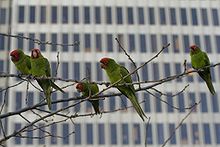- Red-masked Parakeet
-
Red-masked Parakeet 
Conservation status Scientific classification Kingdom: Animalia Phylum: Chordata Class: Aves Order: Psittaciformes Family: Psittacidae Genus: Aratinga Species: A. erythrogenys Binomial name Aratinga erythrogenys
(Lesson, 1844)The Red-masked Parakeet, Aratinga erythrogenys, is a medium-sized parrot from Ecuador and Peru. It is popular as a pet and considered a good talker. It is known in aviculture as the Cherry-headed Conure.
Contents
Description
Red-masked Parakeets average about 33 cm (13 in) long, of which half is the tail. They are bright green with a mostly red head on which the elongated pale eye-ring is conspicuous; the nape is green. Also, the lesser and median underwing coverts are red, and there is some red on the neck, the thighs, and the leading edge of the wings. Juveniles have green plumage, until their first red feathers appear at around the age of four months.
Its call is two-syllabled, harsh and loud.
Breeding
Clutches average 3 to 4 eggs and incubation is 23 or 24 days. Nests are usually made in tree cavities. Juvenile birds fledge after 50 days with green plumage.
Range
These birds are native to southwestern Ecuador and northwestern Peru, where they inhabit forest edges and partially cleared areas.
Status
It has been the tenth most common Neotropical parrot imported into the USA with over 26,000 parakeets checked in from 1981 to 1985. This bird was formerly more common in its limited range, and only fairly recently has been reclassified from a species of least concern to a species near threatened (1994).
Feral populations
 Parrots on Telegraph Hill, San Francisco.
Parrots on Telegraph Hill, San Francisco.
Escaped cage birds are considered to be introduced in Spain. They are also found in Florida, Hawaii, and California, and make up most of the feral population in San Francisco that are documented in the film The Wild Parrots of Telegraph Hill by Judy Irving based on the book of the same name by Mark Bittner. Although these birds reproduce in the wild, the Red-masked Parakeet is not considered established in North America. Breeding populations of feral parakeets have been observed in San Diego County, Los Angeles, San Gabriel Valley, Sunnyvale, Houston, Texas (by Stephanie, Paige and Jessie of Shepherd Forest) and San Francisco.[1] The birds have been observed feeding on the fruits of the cultivated tropical vegetation and nesting in the ubiquitous palm trees.
References
- BirdLife International (2008). Aratinga erythrogenys. In: IUCN 2008. IUCN Red List of Threatened Species. Downloaded on 6 May 2006. Database entry includes a brief justification of why this species is near threatened.
- David Sibley (2000). The Sibley Guide to Birds. Knopf. ISBN 0-679-45122-6.
- Handbook of the Birds of the World Vol 4, Josep del Hoyo editor, ISBN 84-87334-22-9
References
External links
- Page on the Red-masked Parakeet from the Parrot Project
- Page on the "Cherry-headed Conure" at the International Conure Association website
- Site about the feral flock in San Francisco, with many photographs and much information
- Florida Breeding Bird Atlas: Red-masked Parakeet
- "Red-masked Parakeet - BirdLife Species Factsheet". BirdLife International (2008). http://www.birdlife.org/datazone/species/index.html?action=SpcHTMDetails.asp&sid=1567&m=0. Retrieved 3 January 2009.
Categories: IUCN Red List near threatened species | Parrots | Aratinga | Birds of Ecuador | Birds of Peru | Introduced birds of Hawaii | Birds kept as pets | Feral parrots
Wikimedia Foundation. 2010.



